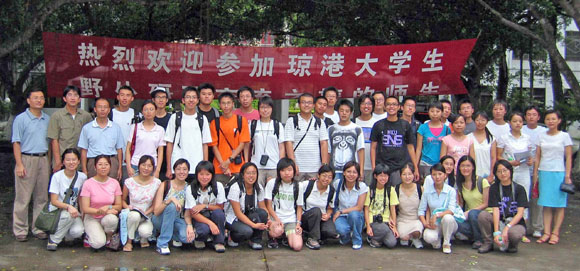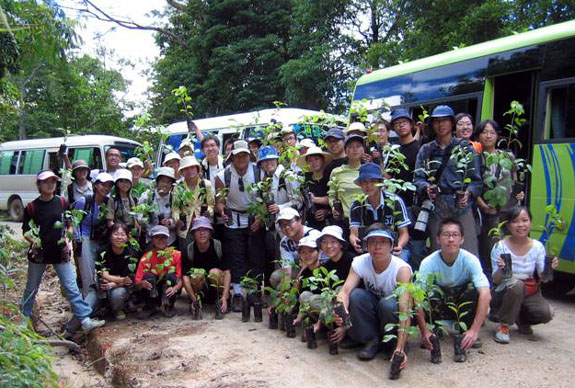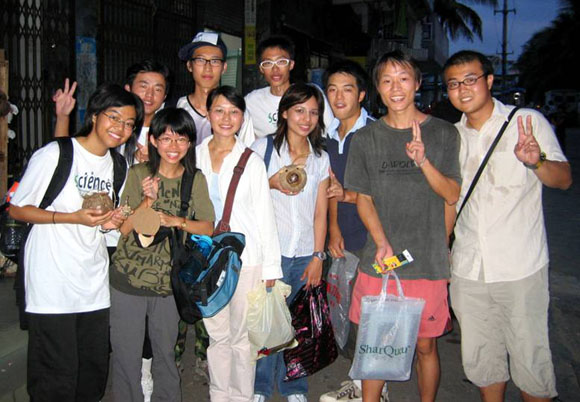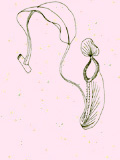
 |
 |
Miscellany (pdf)
|
Kadoorie Farm & Botanical Garden - wildlife updates & sightings |
Environmental Life Science (ENS) students in Hainan, China (pdf)
by Vivian Lam Yan Yan (ENS 2), Wan Pak Ho (ENS 3) and Fu Wing Kan (ENS 2)
On the 29 July 2005, a combination of 20 year 1 & 2 ENS students embarked on a once-in-a-lifetime journey to Bawangling National Nature Reserve, Hainan Island, to participate in the Hainan gibbon (Nomascus sp. cf. nasutus hainanus) conservation project of the Kadoorie Farm and Botanic Garden (KFBG). The trip was organized and led by Dr. Billy Hau, Mr. Yu Yat-Tung, Mr. Allen To and Ms. Maria Lo of DEB as well as Ms. Sharon Chow, Dr. Bosco Chan, Dr. Ng Sai Chit and Mr. Ken So of KFBG. Fifteen undergraduate students and 3 teachers from the Hainan Normal University also joined us in this trip. The trip was kindly supported by Wofoo Social Enterprises (see Box 1) (Fig. 1).
The trip came to a shaky start as a typhoon hit the island on the first two days, delaying our schedule and making the road to our anticipated gibbon observation point inaccessible. Luckily, after 3 hours of a much-feared bus ride (with ideas of falling into the swirling waters any moment popping into our heads), we arrived at the Bawangling Nature Reserve safely, thanks to the courageous and skilled bus driver. The first programme was a valuable chance to listen to the experiences of the pioneers of conserving the Hainan gibbon, Prof. Liu Zhenhe and Mr. Hong Dewei who worked at the reserve in the 1970s and 1980s.
 |
|
Fig.1. A group photo taken at Hainan Normal University, Haikou City. |
Bawangling National Nature Reserve was established for the protection of the endangered Hainan gibbon (Fig. 2). Since the late 1990s, KFBG has been helping the Chinese authorities to enhance the protection of this highly endangered species. Only 13 gibbons appeared in Bawangling in the latest survey in 2004, the entire global population!
 |
|
Fig. 2. Hainan gibbon Nomascus sp. cf. nasutus hainanus (Photo: Bawangling NNR). |
During these 10 days, we mixed with the Hainan students and split into small groups for projects. We were shown around different areas of the nature reserve. Although we were unable to see the Hainan gibbons due to a landslide blocking the road to the gibbon site during the typhoon, none of us was disappointed as we saw many other interesting species, such as the very cute Rufous Woodpecker (Fig. 3). The field trips inside the reserve were also made so much more meaningful through the company of knowledgeable local staff who patiently guided and taught us along the way. We have learnt a great deal from these field trips which have broadened our interests to many different taxa groups.
 |
|
Fig. 3. Rufous Woodpecker, Celeus brachyurus. |
We also had a night safari on a seemingly peaceful and quiet night with stars illuminating the ebony black sky… and yet, we managed to see quite a lot of wildlife in action ranging from flying squirrels to frogs and even snakes! It was amazing that over 10 frog species were found in one single stream in the reserve (Fig. 4). There were a lot of ‘firsts’ on that night; the first time seeing so many stars, hiking at night, rushing at full speed into total darkness, staring at dozens of fireflies and close contact with a leech. Besides getting to know the biodiversity of this unique place, we also participated in a tree planting project which aims to restore a forest corridor linking two patches of forests utilized by the Hainan gibbons (Fig. 5).
 |
|
Fig. 4. Hainan Cascade Frog, Amolops hainanensis. |
 |
|
Fig. 5. Setting off to plant native tree seedlings for the Hainan gibbon. |
We visited several villages of different ethnic minorities in the surrounding areas of the nature reserve in the participatory rural appraisal (PRA) exercise. To many of us, the PRA exercise was a unique and valuable chance to understand the life of local villagers, some of whom are living below the poverty line. Poverty has led to serious conflict between resource users and nature conservation as many local people rely on biodiverse resources in the forest for food, fuel and medicine. The PRA exercise enabled us to understand and appreciate the difficulties in nature reserve management in rural China through first-hand experience (Figs. 6 & 7). Conservation is indeed not an easy or straightforward task! Determination, expertise and continuous hard work are vital. Conservation measures have to be done progressively with the cooperation of local villagers. Conservation is a much more challenging task than we had ever imagined.
 |
|
Fig. 6. Conducting a PRA interview with a local villager outside his house. |
 |
|
Fig. 7. A picture with the village children (Photo: KFBG). |
An amazing part of this trip is how it brought together many people with the same interest in, and passion for, conserving the environment. We truly enjoyed ourselves immensely and did not want this trip to end. We will always cherish this chance of spending quality time with experienced field experts who gave us lots of valuable advice on learning and careers. Working closely with the Hainan students on the group projects was also a very valuable experience. Being brought up in a different culture and environment, we have very different logic and working styles. It was not easy at the beginning but we soon found ways to compromise with each other. The Hainan students were very good hosts throughout the trip and took us around Haikou City during our last night in Hainan (Fig.8). We were all overwhelmed by their hospitality and passion and we have been keeping in touch through the Internet after the trip.
 |
|
Fig. 8. Having fun in Haikou city! |
This trip has highlighted the importance of learning outside the classroom. Despite our busy schedule at school, we will seize every opportunity to go out and explore (even if it is just in Lung Fu Shan behind the University!). This is just one of the good habits that the trip has helped us to develop. This trip has also led us to think about the possibility of working in the Mainland for conservation. Lastly, this was no ordinary field study trip. Together, we’ve been through a whole array of new experiences, from tasting hairy vegetables to the joy of learning about new species and seeing the innocent smile of a village child. There is simply just way too much to tell. The trip was an experience of a lifetime for all of us.
|
Box
1
|
|
Wofoo Social Enterprises (WSE) Wofoo Social Enterprises (WSE), chaired by Mr. Joseph Lee, BBS, JP, gained momentum in the 1990s as a pioneer in advocating and supporting not-for-profit models of social services. WSE believes in the benefits of an entrepreneurial approach to providing social services because of its emphasis on customer-care and focus, efficiency and innovation - only through such manner can limited resources be mobilized and shared to meet the increasing demands of society. In parallel, WSE inspires individuals and organizations from different walks of life, sectors and groups, to contribute to Hong Kong’s social services. On this common platform and joint belief, WSE can join hands with many to enhance "Harmony amongst people to Build Prosperity of our Home and Country", to illustrate the principle of "socializing social service." After years of gestation, WSE is striving for further development based on its solid foundation of services in areas of Youth Development, Education, Elderly Care, Humanitarian Services, and Strategic Partnership. At present, the WSE Family includes Wofoo Foundation, Chinese Youth Exchange Centre (Hong Kong), Hong Kong Youth Institute, Warehouse Teenage Club, School of Continuing Family Education, Beijing International Committee for Chinese Orphans, Civic Heritage, W F Joseph Lee Primary School and Grace Nursing Home (Kowloon Tong and Tak Tin). W F Joseph Lee Primary School became the first primary school operating on the Direct Subsidy Scheme in the New Territories when it first admitted students for Fall 2002. Furthermore, Grace Nursing Home (Tak Tin) established another milestone for WSE and Hong Kong’s social services when it became the first private sector operator of a Social Welfare Department tendered home in 2004. Heading towards the future, WSE will continue to fulfill its corporate citizen duties and contribute to building a harmonious society and country by uniting societal energies, and providing social services of high quality. |
| P.12-15 |
|
Porcupine! |
 Copyright © 2000 |
